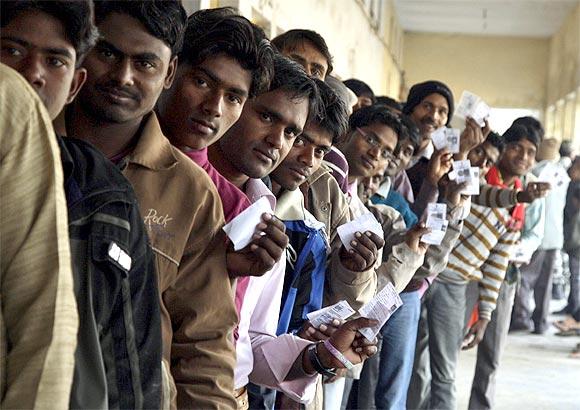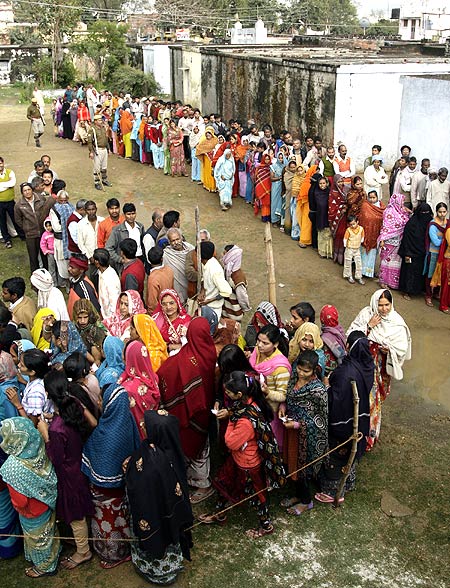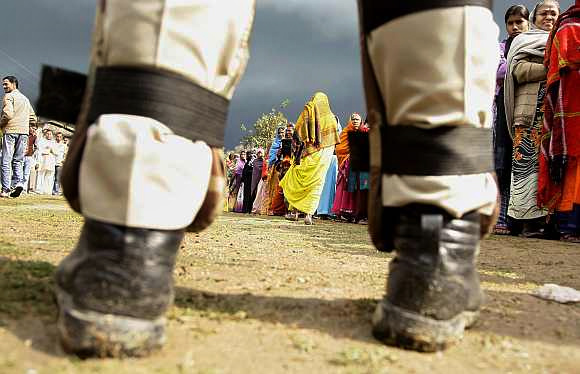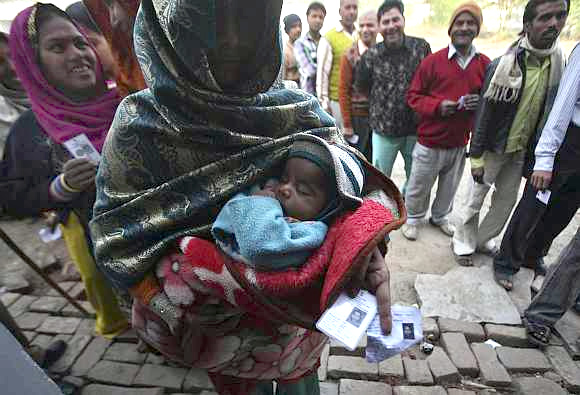 | « Back to article | Print this article |
Who will rule Uttar Pradesh?
The high voter turnout in Uttar Pradesh has made any predictions about such a massive electoral exercise more difficult and confusing, says Sharat Pradhan
Tuesday will not only determine the political fate of India's most populous state, Uttar Pradesh, but it will also mark the success or failure of several political bigwigs who led the campaign of their respective political outfits.
In what was touted as the "mother of all elections", which came to an end on Saturday, the fate of 6,839 candidates were sealed in electronic voting machines in 402 constituencies spread across 75 districts.
Counting begins at 7 am on Tuesday to determine the political destiny of the state, which is widely perceived as the route to power in New Delhi.
At the top of the list of those -- whose prestige is at stake -- is Congress leader Rahul Gandhi, who led the party campaign across the sprawling state.
Gandhi's future at the power centre of Delhi also hinges on whether he is successful in the state polls.
Click NEXT for more...
Who will rule Uttar Pradesh?
The results are also likely to redefine the political stature of other Congress leaders like Digvijay Singh and Beni Prasad Verma, who have been seen as members of Rahul's inner coterie for quite some time.
Besides, the popularity of Bharatiya Janata Party's star campaigner Uma Bharti, who was even named as the party's chief ministerial candidate, will also be put to test.
Samajwadi Party supremo Mulayam Singh Yadav's son and state president Akhilesh Yadav 's potential as the inheritor to his father's legacy is also at stake.
This election will also display whether Bahujan Samaj Party supremo Mayawati's governance has been accepted or rejected by the people of UP.
As many as 7.57 crore out of the 12.73 crore listed voters exercised their rights in the election that is currently the prime focus of India's national polity.
Click NEXT for more...
Who will rule Uttar Pradesh?
Sure enough, the high voter turnout has made any predictions about such a massive electoral exercise more difficult and confusing.
The high turnout is being interpreted differently by each of the key political parties in the fray.
"The high turnout of voters simply reflects the anger of the people against the ruling BSP, whom they wish to vote out this time," claims Akhilesh Yadav, state president of the Samajwadi Party.
SP has been projected as the potential winner in several exit polls undertaken over the last 48 hours.
Akhilesh also emerged as a potential rival to none other than Congress's star campaigner Rahul Gandhi, as far as their appeal as a youth icon is concerned.
Click on NEXT for more...
Who will rule Uttar Pradesh?
Uttar Pradesh Congress unit chief Rita Bahuguna Joshi claims, "The newly enrolled voters were quite impressed by Rahul Gandhi and therefore the bulk of the youth have opted for the Congress party."
Dismissing the exit poll results, she claims, "The results will prove that the Congress is way ahead of whatever these surveys are showing."
Bhartiya Janata Party national vice president Kalraj Misra, who was also in the fray from Lucknow, sought to explain, "People are sick of both the SP and the BSP, while the Congress stands badly discredited on account of its involvement in multi-billion scams in New Delhi. Therefore, the additional votes have gone into the BJPs' bag."
Interestingly, even though all exit polls had clearly spelt doom for the BSP, its leadership is still hoping to bounce back.
If it does not manage to get enough seats on its own, the BSP is hoping to get enough to be in the race to form the government, with the support of either the Congress or the BJP.
Click on NEXT for more...
Who will rule Uttar Pradesh?
"We do not believe in exit polls and surveys. They are fudged or fixed," said party spokesperson Surendra Bhadoria dismissively.
As many as 1,50,000 EVMs were installed at 1,33,000 polling stations, where unprecedented security arrangements were made to ensure free, fair and violence-free elections.
"What gives me the greatest satisfaction is that our effort to inculcate the urge to vote among the people of the state has borne fruit. The entire election has passed off without any untoward incident," UP Chief Electoral Officer Umesh Sinha told this scribe.
The seven-phased election spread over a month-long span started on February 8, when the first round of polls took place in the eastern strip of UP. It concluded on March 3 in another part of western UP, along the long stretch of the India-Nepal border.
Click on NEXT for more...
Who will rule Uttar Pradesh?
This election created a history of sorts when the turnout touched an all-time high of 59.5 per cent -- higher than the turnouts during 1977 and 1993 -- the two elections widely regarded as the watershed in India's electoral history.
Held right after the Emergency era, the 1977 elections had marked the fall of then Prime Minister Indira Gandhi and the first devastating defeat of the Congress party since India's freedom in 1947.
The election in 1993 witnessed the impact of the demolition of the Babri Mosque in Ayodhya on December 6, 1992.
"The high turnout at the 2012 UP state election becomes extremely significant as even in 1977 and 1993, it had not crossed 57 per cent," said Sinha.
He added, "Other than the efforts of the Election Commission, it was also the response of the public, particularly the youth, that made much of the difference. Even as we enrolled 1.7 crore new voters, the voter turnout went up by 2 crore".
Click on NEXT for more...






